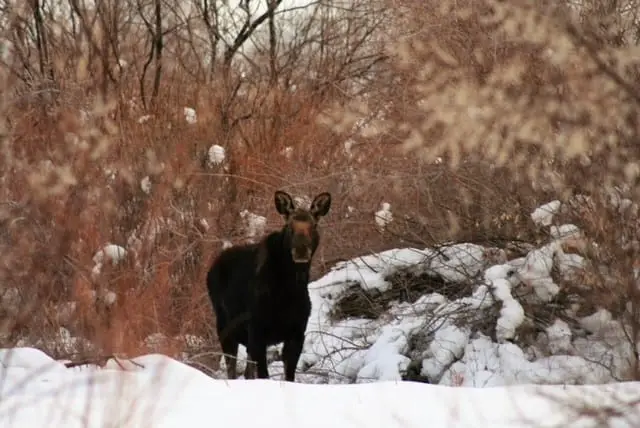Colorado is the state where the Great Plains run up to the foot of the Rocky Mountains. The state holds a vast array of wild animals. Some of these animals are downright dangerous.
Below is a list of dangerous mammals, dangerous snakes, dangerous insects, and dangerous arachnids that live in the state of Colorado.
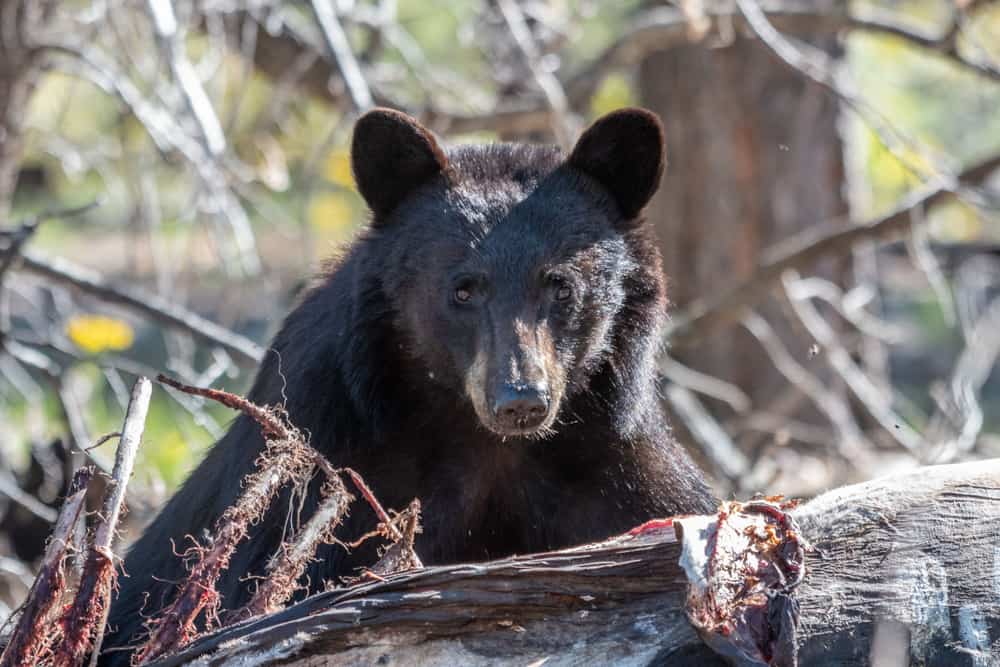
Black Bears (Ursus Americanus)
From 2000 through 2023, Black Bears have killed thirty-one people in North America.
The following is a list of fatal Black Bear attacks in Colorado from 1971 through 2021:
- In 1971, a 31-year-old man was camping on private property just west of Rocky Mountain National Park when he was dragged from his tent and killed by a black bear. The bear also injured the man’s newlywed wife, who was also in the tent. See
- In 1993, a 24-year-old logger was camping on Waugh Mountain in Colorado while he cut timber. On August 10th, a black bear broke into his trailer and killed him. See
- In 2009, a 74-year-old woman was killed and partially consumed by a black bear or multiple black bears in her home in Ouray, Colorado. This lady was known to feed bears on her property. In fact, she had been warned multiple times by CPW officials to cease doing so. Bears that are habituated to human food are much more dangerous to humans. See
- In 2021, a 39-year-old woman from Durango, Colorado, was out walking her 2 dogs when she was killed and partially consumed by a female black bear with 2 cubs. The woman’s boyfriend found her body after the dogs returned home without her. See
Colorado Parks and Wildlife estimates that there are between 17,000 and 22,000 black bears in the state.
Black bears are the least aggressive bear species in North America, but they’re still dangerous.
Most people rightfully consider black bears to be much less dangerous than grizzly bears. However, even though black bears are our least aggressive bear species, they’re still dangerous. In fact, on average, black bears kill at least one person somewhere in North America each year.
American black bears are generally not an aggressive species of bears. Like all bears, they’re omnivores, which means their diet includes plant material but also meat. At times, Black Bear’s food sources have been documented to consist of 96% plant material. This makes them one of the least predacious of all carnivores.
Most of the time, you won’t even realize that a black bear is close by because when they detect your presence, they’ll quickly exit the area. People know this and unfortunately become complacent in black bear country to the small percentage of the time that they are in danger.
Human-habituated black bears
Black bears are very fast learners, and when they figure out that humans are an easy source of food, they quickly become habituated to people. Black bears that are habituated to human food and garbage and have lost their fear of humans are a danger. When people don’t provide the food that they’re accustomed to, they become aggressive. When people intentionally habituate black bears to human food, they not only put themselves in danger but also endanger anyone else who comes in contact with that bear.
Predatory black bears
The second type of dangerous black bear is the predatory bear. According to Doctor Stephan Herrero in his book “Bear Attacks, Their Causes And Avoidance,” from 1900 through 1980, 90% of the fatal attacks by black bears on humans in the United States and Canada were carried out by a predatory animal.
In other words, 90% of the time, when black bears attack people, it’s because they view them as a food source.
From late summer through the fall, bears are in a hyperphagic state. An average adult black bear takes in 5,000 to 8,000 calories per day in the springtime and summer.
The same bears that were consuming up to 8,000 calories per day earlier in the year are taking in around 20,000 calories a day in the late summer and fall to store up energy to use during their hibernation. Bears in the coldest climate regions hibernate for up to seven months out of the year. In warmer areas, hibernation may only last a few weeks or be non-existent.
In 88% of the cases of fatal Black Bear attacks on humans referenced in the article “Fatal Attacks by American Black Bear on People” by Stephan Herrero, Andrew Higgins, James E. Cardoza, Laura I. Hajduk, and Todd S. Smith, a lone male bear that was stocking up on calories pre-hibernation was the culprit. See
Also, see
My final take on black bears.
The thing to extrapolate from the above information is that black bears are slightly more dangerous in the late summer and fall. The odds are still very low, though, that one will ever bother you. Nevertheless, there is that small chance. Here is an account of a Colorado black bear attack from 2023.
My final take on the danger of black bears is this. There is a potential danger in everything we do. When I’m out in what is exclusively black bear country, I never consider myself to be in any sort of danger. The chances of running into a predatory black bear are extremely remote.
If I were in the wilds of Alaska and Canada or even in Yellowstone National Park, where there are brown bears, polar bears, and grizzly bears, I might consider carrying a canister of bear spray to be on the safer side. On the other hand, the guy who is being mauled by a black bear might wish he’d have left home with his can of bear spray too.
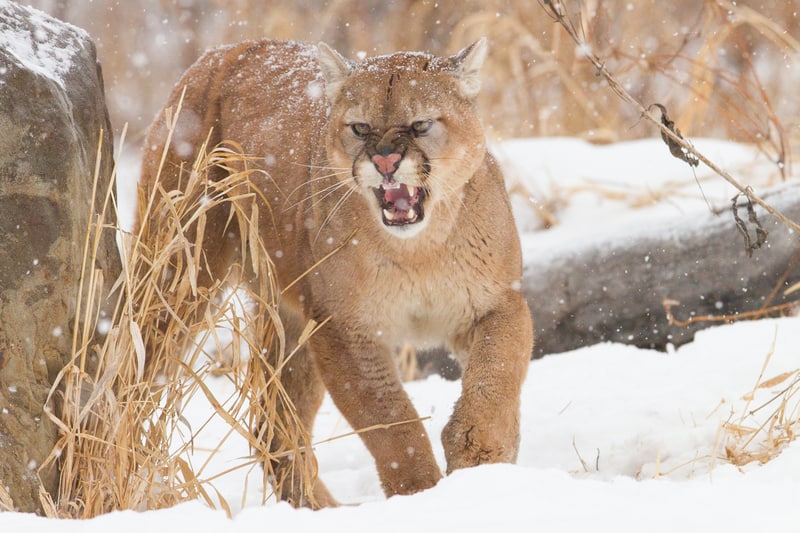
Mountain Lions (Puma concolor)
Mountain lions, which are also called cougars, are dangerous animals.
They’re the second largest feline predator in the western hemisphere. What’s more, adult mountain lions are capable of taking down and killing wild animals as large as adult moose.
Cougar attacks on humans are relatively rare, but they do occur.
From 1868 through 2018, there were at least 27 and possibly 28 fatal mountain lion attacks on humans in North America. See
What’s more, from 1990 through 2023, there have been 24 known mountain lion attacks in Colorado that have resulted in human injury. See
Below is a partial list:
- In 1991, a mountain lion attacked, killed, and partially consumed an 18-year-old cross-country runner in Idaho Springs, Colorado. See
- In 1997, a 10-year-old boy was hiking with his family in Rocky Mountain National Park when he was attacked and killed by a mountain lion. See
- In 2019, a 31-year-old trail runner was in the Horsetooth Mountain Open Space area just outside of Fort Collins, Colorado, when he was attacked by a sub-adult mountain lion. Although the man sustained serious injuries, he managed to kill the cougar with his bare hands. See
According to a 2021 Colorado Parks and Wildlife report, the state has between 3,800 and 4,400 mature mountain lions.
How dangerous are mountain lions?
- “How big are mountain lions?” you might ask. The largest adult male mountain lions are over 8ft long from the tip of their nose to the tip of their long tails and weigh up to 220 lbs. Females, on average, are around 13% smaller than males.
- An adult mountain lion can run up to 50 miles per hour and leap up to 18 feet laterally and 40 feet horizontally.
- Mountain lions have a bite force of 725 psi
- Mountain lions use their stealth to attack from behind most of the time. They leap on the backs of their prey and clamp down on either their spinal cord or windpipe with their powerful jaws.
- Mountain lions are so good at camouflaging their presence that they’re bona fide ghosts in their environment, especially in good cover. Luckily, most of the time, they use their skills to avoid any human contact. However, as we’ve established above, there are times when they seek out humans as prey.
What do mountain lions eat?
Mountain lions mainly prey on deer. In fact, on average, an adult mountain lion kills a deer or the equivalent of a deer in biomass once a week. They also prey on other animals.
In Colorado, mountain lions prey on large mammals such as mule deer, white-tailed deer, elk, moose, bighorn sheep, Rocky Mountain goats, pronghorns, and feral horses. They also prey on small mammals, birds, pets, livestock, and literally any other native wildlife they can catch. See
Also, see Wild Cats in Colorado
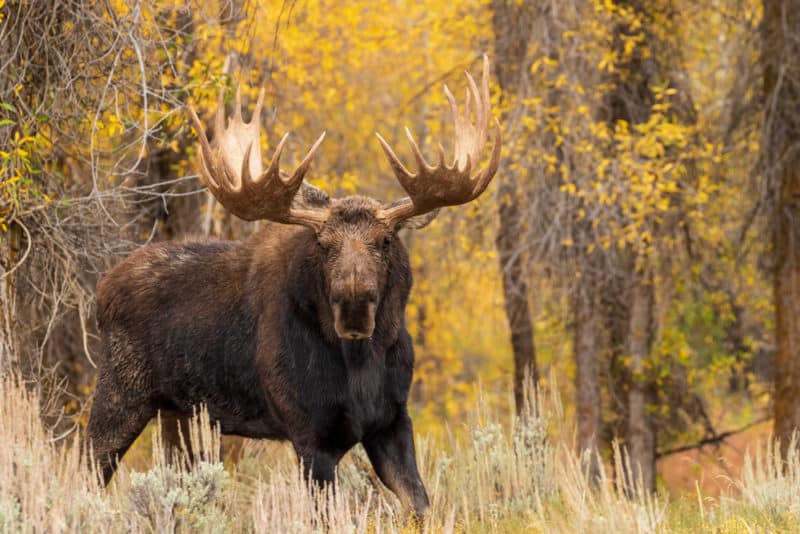
Moose (Alces alces)
Although they look placid, moose are temperamental, and if you invade their space, they are extremely dangerous.
Every year, moose are responsible for more attacks on humans than any other North American wildlife species. In fact, Alaskan moose attack humans more than all the state’s large predators, which are black bears, grizzly bears, brown bears, polar bears, and wolves combined. See
There were 6 recorded moose attacks on Humans in Colorado in 2022. Again, as of September, there have been 3 more moose attacks in the state in 2023.
Here is an account of a cow moose attacking a Colorado hiker in September of 2023.
Also, see Are Moose Dangerous to Humans?
“Although they seem like solitary, peaceful animals that aren’t aggressive, moose can be dangerous when they’re provoked. The trouble is people don’t realize they’re provoking them.
Unlike other members of the deer family, unless they’re in an area with heavy hunting pressure, moose are relatively unafraid of humans. Hence, they won’t run away because you are there.
Their boldness makes people with no outdoor experience more tempted to approach, feed, or even try to pet them. Like most wild animals, moose will become aggressive when irritated and defend their territory or young calves when they feel threatened.
Although they seem bored and slow-moving, moose can cover ground very quickly with those long legs when they decide to.
How fast do moose run? Moose can run up to a speed of 35 miles per hour (56.42 kph) for short distances. That means they can cover 50 yards (46 meters) in just under 3 seconds.
If you are not far enough away that you can hide behind the nearest tree trunk before an animal traveling at that speed can get to you, you are too close. It’s time to move away. If a moose attacks you, it will use its mass and power to knock you down then it will kick and stomp you with all four of its feet.
When Are the Moose Most Dangerous?
The time of year and the annual cycles of mating and raising young have some influence on when moose will exhibit more natural aggression. Knowing when these times are will help you be more vigilant in avoiding otherwise dangerous situations.
Are bull moose dangerous?
Normally, male (bull) moose are more aggressive than female moose (cows), especially during the fall mating season. This occurs in late September through early October. During the breeding season or “rut,” bull moose are competing for the right to breed cow moose. This makes them territorial animals that are more irritable and restless. At such times, the probability of one attacking you increases.
Are cow moose dangerous?
Cow moose are more likely to be aggressive from late spring through late summer when they have young moose calves to protect.
Moose are also more likely to attack in the winter if emaciated or tired from walking in deep snow.
Another reason why a moose can become dangerous and aggressive is a case of a brain worm infection. These infections make the animal less inclined to behave in a predictable manner and thus more of a danger to unassuming humans.”
Colorado’s moose are from the smallest moose sub-species (A. alces shirasi) or Shiras moose. See, They are not a native species to the state but were first introduced in 1978.
Colorado, wildlife officials say there are around 3,500 moose in the state. See
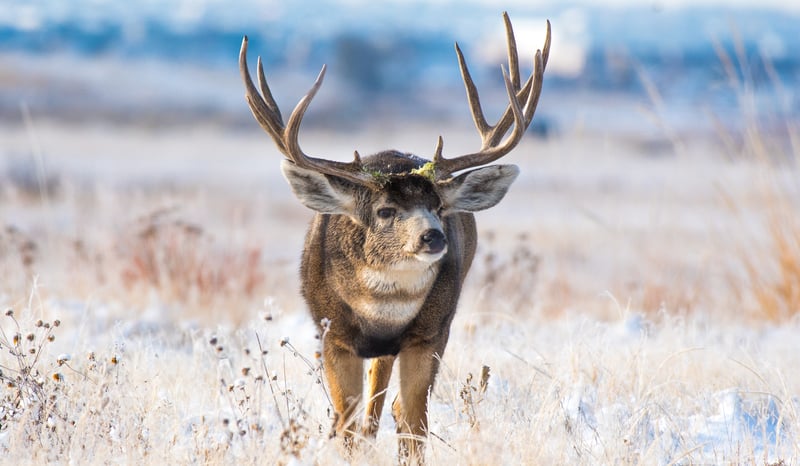
Deer (Odocoileus hemionus) and (Odocoileus virginianus)
At first glance, deer do not seem overly dangerous. However, when you take into account the number of people that are injured or even killed in deer-related highway accidents each year, it becomes clear that deer have their place among the state of Colorado’s most dangerous creatures.
Deer/vehicle crashes injure around 59,000 people in the United States each year. Around 440 of those people die from their injuries.
Believe it or not, deer also occasionally physically attack people. See Do Deer Attack Humans?
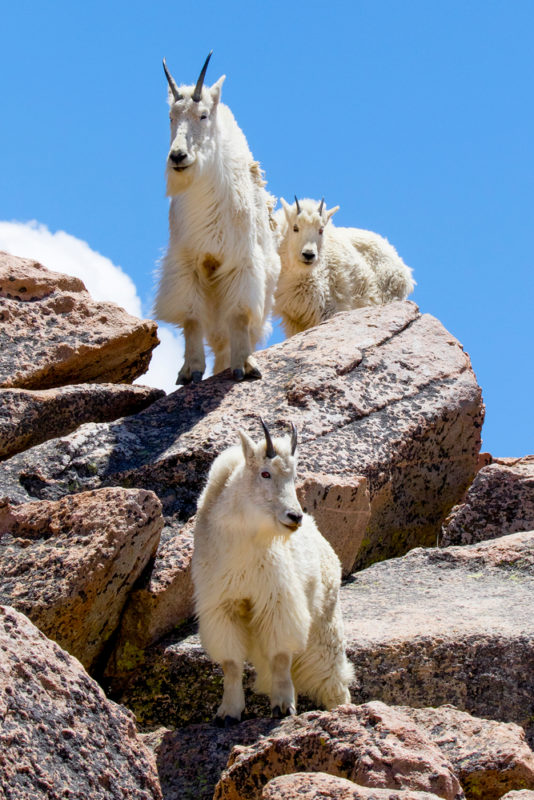
Rocky Mountain Goats ( Oreamnos americanus)
Rocky Mountain goats are dangerous animals under the right circumstances. There is more than one account of a mountain goat killing a grizzly bear with its horns. There’s also one account of a mountain goat goring a hiker to death In Olympic National Park. See
To all intents and purposes, Rocky Mountain Goats appear to be about as dangerous as white hairy domestic goats. There is, however, more to them than meets the eye. Nature has weeded out the weak and the unfit from these animals. They may look and act peaceful, but they become fierce when they feel crowded or threatened.
Male goats, or billies, become more aggressive and belligerent during their breeding season, which begins in October and runs in December.
The real danger to humans comes when mountain goats become accustomed to seeing people. At times mountain goats become so habituated to humans that they allow them to approach very close. In turn, some people foolishly assume that these animals are not dangerous because they don’t run away.
No matter how accustomed people and mountain goats might become to each other, these are still wild dangerous animals, so keep your distance. See
Surprisingly, Rocky Mountain Goats are not native to Colorado. They were introduced to the state back in the 1940s. Today the Centennial state hosts 1,500 to 2,000 of them.
Rattlesnakes
The only venomous snakes in Colorado are rattlesnakes. Rattlesnakes are pit vipers that envenomate their prey with venom from glands in the roofs of their mouths through hollow fangs. Rattlesnakes also use their venom defensively if they feel they are being threatened. This is where they become dangerous to humans.
In an average year, rattlesnakes bite around 200 people in Colorado. Rattlesnake envenomation has the potential to cause necrosis or tissue death, blood cell damage, and internal bleeding, along with heart, respiratory, and kidney failure. In rare cases, people die from rattlesnake bites. In fact, in 2022, a six-year-old boy from Colorado Springs died after being bitten by a rattlesnake. See
Also, see: Venomous Snakes of Colorado
Fortunately, with prompt medical attention, which may include the administration of antivenom, rattlesnake-related deaths are very rare.
If you or someone you are with is bitten by a rattlesnake, the sooner you can get to a hospital, the better the chance of a positive outcome.
Here are four rattlesnake species that live in Colorado:
- Prairie Rattlesnake (Crotalus viridis viridis)
- Midget-faded Rattlesnake (Crotalus concolor)
- Desert Massasauga (Sistrurus catenatus edwardsii)
- Western Massasauga (Sistrurus catenatus tergeminus)
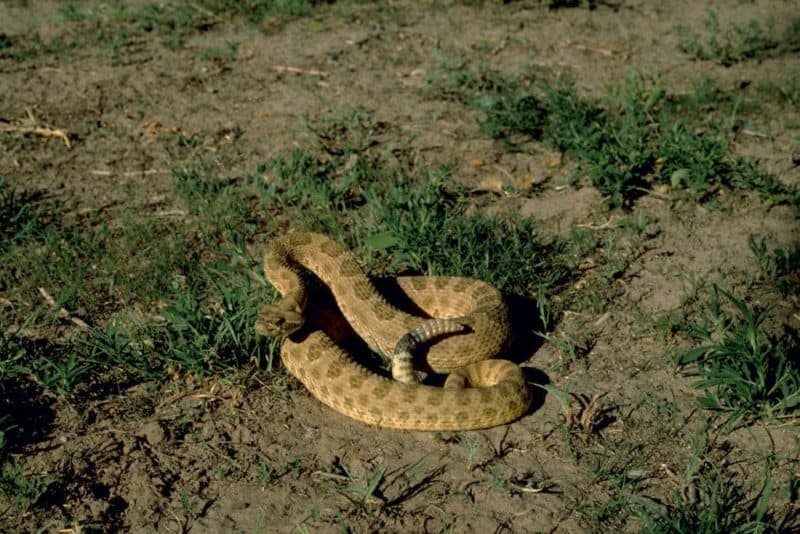
Prairie Rattlesnake (Crotalus viridis)
The Prairie Rattlesnake grows anywhere from 3ft to 5ft long. They are tan-colored with varying shades of brown blotches covering their bodies. They have a distinguishing triangle-shaped head with pit sensory organs on either side. A light stripe runs diagonally from the back of its eye to its jaw, and another strip runs diagonally from below its eye to the corner of its mouth. Prairie Rattlesnakes are mostly ground snakes, but they occasionally climb into shrubs, bushes, or trees. Prairie Rattlesnake bites are both hemotoxic and neurotoxic.
The Prairie Rattlesnake lives throughout Colorado. Look for them in open prairies, semi-desert shrubland, open grasslands, sandhills, piñon-juniper forests, riparian zones, and woodland habitats up to 9,500 ft in elevation. See
They may take up residence in prairie dog towns and live in appropriated prairie dog burrows.
A Prairie Rattlesnake bite’s signs and symptoms include extreme pain, blistering, swelling, nausea, and vomiting. The venom can impair blood coagulation and break down the red blood cells, leading to tissue necrosis, shock, and rarely multiple organ damage. Source
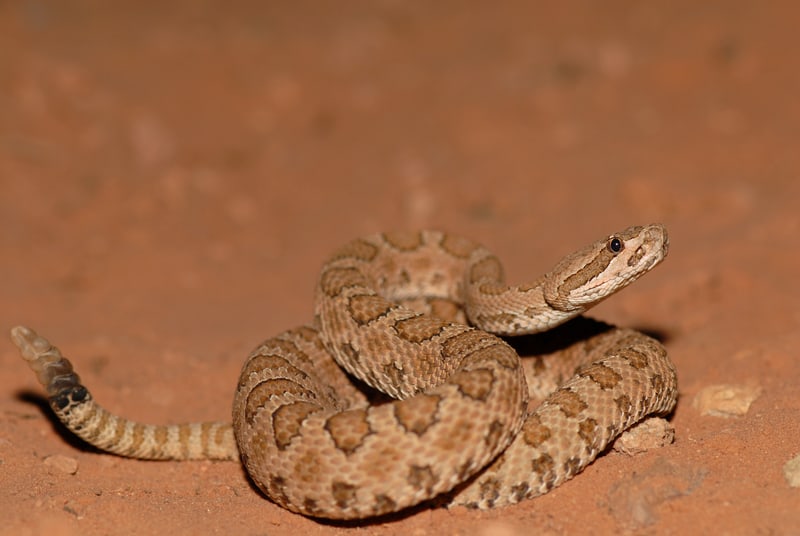
Midget-faded Rattlesnake (Crotalus concolor)
Midget-faded rattlesnakes are cream, brownish-grey, or a straw-like color. They inhabit extreme west-central Colorado. This species is actually a subspecies of the western rattlesnake. They can grow to 20-30 inches in length. Males are usually longer and bigger than females. Rocky areas provide many places to hide and are a normal habitat for the midget faded rattlesnake. This species’ bite can inject you with neurotoxic venom.
Other names for this snake are the Faded Rattlesnake and Yellow Rattlesnake.
A Midget-faded Rattlesnake has one of the most potent venoms in North America. See Its presynaptic neurotoxic bite’s signs and symptoms include extreme pain, blistering, swelling, nausea, and vomiting. The venom can impair blood coagulation and break down the red blood cells, leading to tissue necrosis, shock, and rarely multiple organ damage. Source
In Colorado, Midget faded rattlers live in the west-central portion of the state, in the Green River formation. This area comprises Moffat, Rio Blanco, Mesa, Garfield, Delta, and Montrose Counties.
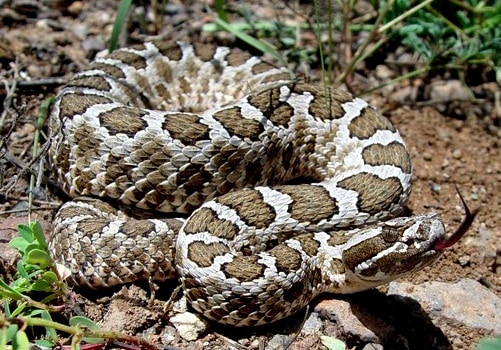
Desert Massasauga (Sistrurus tergeminus edwardsii)
Desert Massasauga rattlesnakes are smaller snakes that reach a body length of 21 inches. They have a pale gray body with dark brown blotches. They also have a dark stripe that goes from the side of the head and across the eye. This snake also has the nickname “buzztale” for its high-pitched rattle sound, which is different from other rattlesnakes. These snakes inhabit the sandy areas of southeastern Colorado.
The venom of the Desert Massasauga rattlesnake is cytotoxic venom that destroys tissue. The cytotoxic venom contains digestive enzymes that disrupt blood flow and prevent blood from clotting. A bite to a human is rare. Most bites occur after someone deliberately handles them or accidentally steps on one.
In the Colorado Desert, Massasauga Rattlesnakes live in the arid grasslands in the southeastern part of the state. See
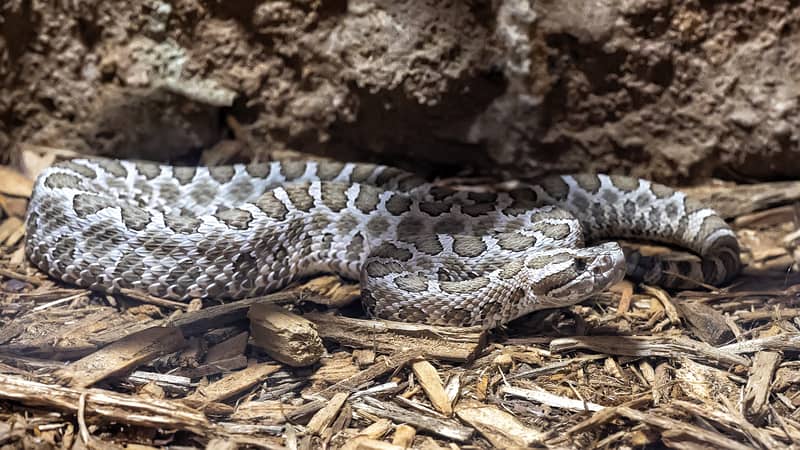
Western Massasauga (Sistrurus tergeminus)
The Western Massasauga rattlesnake grows to a length between 14 – 36 inches. Their body is a light gray with dark brown blotches. They are similar to the Desert Massasauga but lighter in color. They also have a dark stripe that goes from the side of their face and across the eye. These snakes are found in the sandy terrain of southeastern Colorado.
It is given the nickname “buzztale” for its high-pitched rattle sound, which is different from other rattlesnakes.
The venom of the Western Massasauga rattlesnake is cytotoxic venom that destroys tissue. The cytotoxic venom contains digestive enzymes that disrupt blood flow and prevent blood from clotting. A bite to a human is rare. Most bites occur after someone deliberately handles them or accidentally steps on one.
In Colorado, Western Massasauga rattlesnakes live in Lincoln, Cheyenne, El Paso, Pueblo, Crowley, Kiowa, Otero, Las Animas, Prowers, Baca, and Bent Counties.
Being safe in rattlesnake country
If you find yourself moving through a rattlesnake area, pay particular attention to where you place your hands and feet. Unfortunately, rattlesnakes don’t always give a warning before they strike. Additionally, if you are moving through rattlesnake country and you hear the buzz of a rattlesnake, freeze in place until you’ve located the source of the sound. Once you’ve located the snake, the dumbest thing you can do is go in for a closer look. Instead, the best thing you can do is carefully move in the opposite direction until you’ve put a safe distance between you and the snake.
Finally, remember, in the advent of a rattlesnake bite, the quicker the bitten individual receives medical attention, the better the chance of a good outcome.
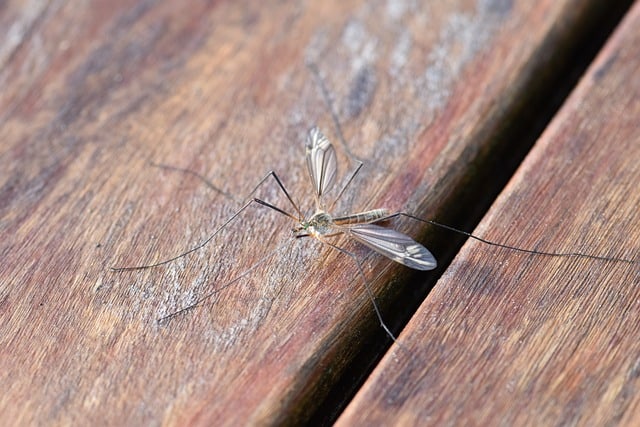
Dangerous Insects in Colorado
Mosquitoes
In terms of the total human fatalities caused by a single organism, mosquitos are by far the deadliest animals in the world. Mosquito bites spread bacteria, viruses, and parasites that cause between 725,000 and 1,000,000 human fatalities annually. See
According to the Centers for Disease Control and Prevention, West Nile Virus is the most common mosquito-borne illness in the United States.
In the time period of 2010 through 2020, the West Nile Virus sickened 22,647 people, of which 1247 of them died.
In 2022, there were 206 human cases of West Nile virus in Colorado. Unfortunately, 20 of these cases caused the death of the infected individual.
Along with West Nile, mosquitos are responsible for spreading other diseases in the United States, such as Dengue, chikungunya, and Zika virus.
To reduce the load of mosquitos around your property, eliminate all sources of standing water. Furthermore, to discourage mosquitos from biting you, wear long sleeves and long pants. Additionally, use an insect repellent containing DEET when you’re out of doors. Some people are allergic to DEET. If you are one of these people, you can use a repellent containing one of the following:
- Picaridin (known as KBR 3023 and icaridin outside the US)
- IR3535
- Oil of lemon eucalyptus (OLE)
- Para-menthane-diol (PMD)
- 2-undecanone
Dangerous Arachnids in Colorado
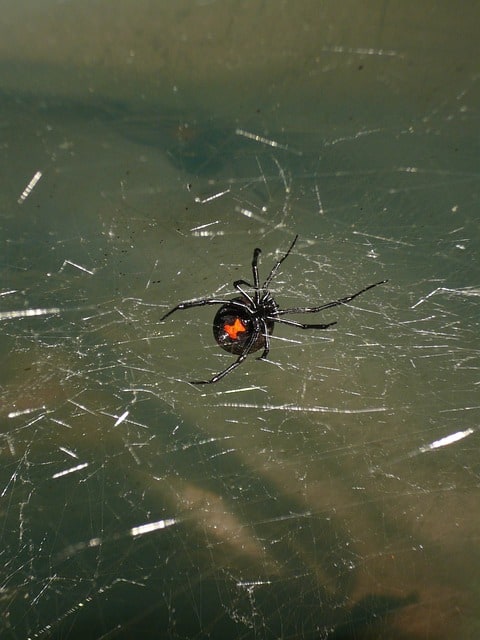
Western Black Widow Spider (Latrodectus hesperus)
The Black Widow is the most dangerous spider in Colorado.
According to the Colorado State University extension, there are several black widow species in North America. However, the Western Black Widow is the dominant widow species throughout the state Of Colorado. See
The average body length of a mature Western Black Widow Spider is around 1/2 an inch. Their legs spread out 1 1/2 to 2 inches. Males are around 1/3 the size of females. The female has a shiny black body with what is generally a red hourglass shape on the bottom of the abdomen. However, the hourglass can also be yellow or white in color.
Black widows have neurotoxic venom that affects the nervous system of bite victims. Their bite is dangerous, particularly to young children and the elderly. However, a black widow bite is rarely fatal.
There is an antivenom available for black widow bites. However, physicians only use it in rarely serious cases.
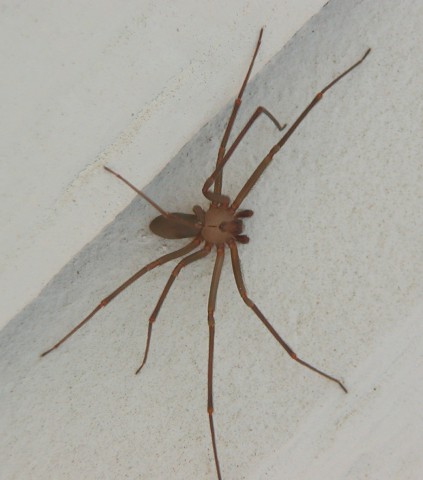
Brown Recluse Spider (Loxosceles reclusa)
Brown Recluse Spiders are usually between 1/4 and 3/4 inches in diameter, with their legs extended. However, there are specimens that grow larger. While they’re typically light to medium brown, they range in color from whitish to dark brown or blackish gray. They generally have a contrastingly dark-colored violin-shaped marking on the top of their cephalothorax, with the neck of the violin pointing to the rear of the spider. This is why they also have the nickname fiddleback spider.
Brown Recluse Spiders have necrotic venom, which can destroy human skin and soft tissue. In extreme cases, bite victims develop a necrotizing ulcer at the sight of the bite that may take months to heal as dead tissue needs to slough away before it can do so. Brown Recluse Bites can also cause death in very rare instances. Most deaths occur in small children or those with a compromised immune system. See
Brown Recluse Spiders don’t have an aggressive nature. They rarely bite human beings. However, when bites do occur, it is usually a case of a person accidentally pressing one up against the skin inside of a glove or article of clothing.
The good news for Colorado residents is that Brown Recluse spiders are extremely rare in the Centennial State. In fact, Brown Recluse specimens at the Denver Museum include only spider that was collected from within Colorado. See
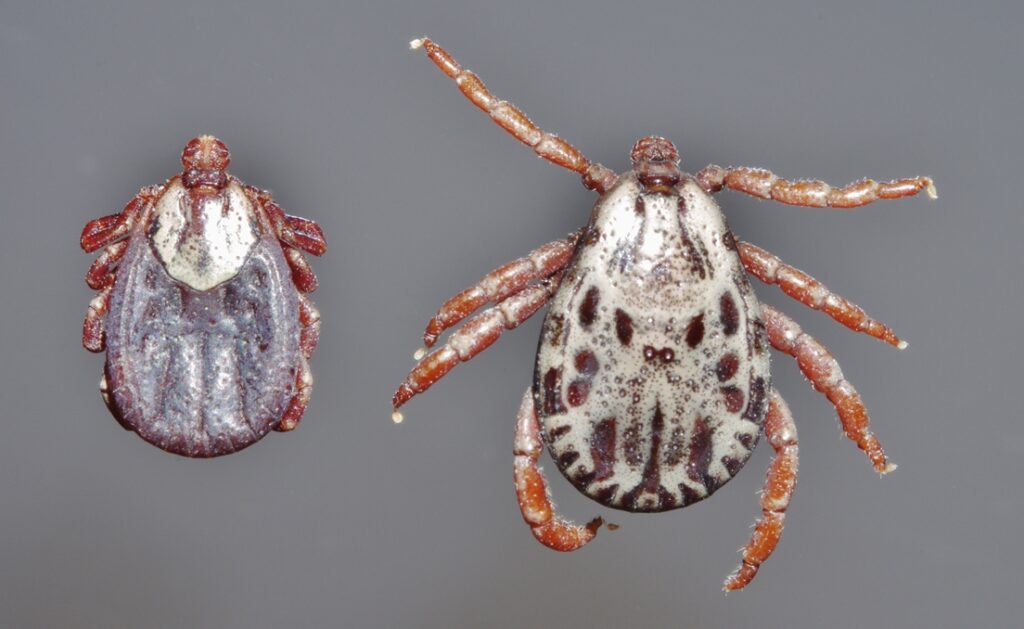
Ticks
Ticks are dangerous to humans due to the infectious diseases that they spread through their bites.
According to the UC Health website, there are about 30 different species of ticks in Colorado. The most common ones are the Rocky Mountain Wood Tick (Dermacentor andersoni) and the American Dog Tick (Dermacentor variabilis).
The table below lists some of the tick-borne diseases present in Colorado.
| Colorado Tick Fever | Some symptoms of tick-borne illnesses are fever, chills, head and body aches, and fatigue. Some patients have a sore throat, abdominal pain, vomiting, and/or skin rash. In rare severe cases, CTF affects the patient’s central nervous system with stiff neck and confusion. Deaths from the CTF virus are rare. Treatment for Colorado Tick Fever includes rest, fluids, and over-the-counter pain medications. People with severe cases may need to be hospitalized and given intravenous fluids. |
| Tickborne Relapsing Fever | Tickborne Relapsing Fever is a rare infection. Symptoms include a high fever, headaches, and body aches. Symptoms occur in a pattern with 3 days of symptoms followed by 7 days of no symptoms followed by 3 days of symptoms. Without antibiotic treatment, this pattern may repeat itself several times. |
| Tularemia | Symptoms of RMSF include high fever, rash, headache, and vomiting. Some patients who have had severe cases of Rocky Mountain Spotted Fever may be left with permanent damage such as loss of limbs, hearing loss, paralysis, and cognitive disability. Early treatment with the antibiotic doxycycline can prevent death and severe illness. |
| Rocky Mountain Spotted Fever | Symptoms of RMSF include high fever, rash, headache and vomiting. Some patients who have had severe cases of Rocky Mountain Spotted Fever may be left with permanent damage such as loss of limbs, hearing loss, paralysis, and cognitive disability. Early treatment with the antibiotic doxycycline can prevent death and severe illness. |
Lyme disease, which is a major tick-borne illness, is not present in Colorado. Several Coloradoans become ill with Lyme Disease every year, but so far, all of these cases have been contracted in other states where Lyme disease is present.
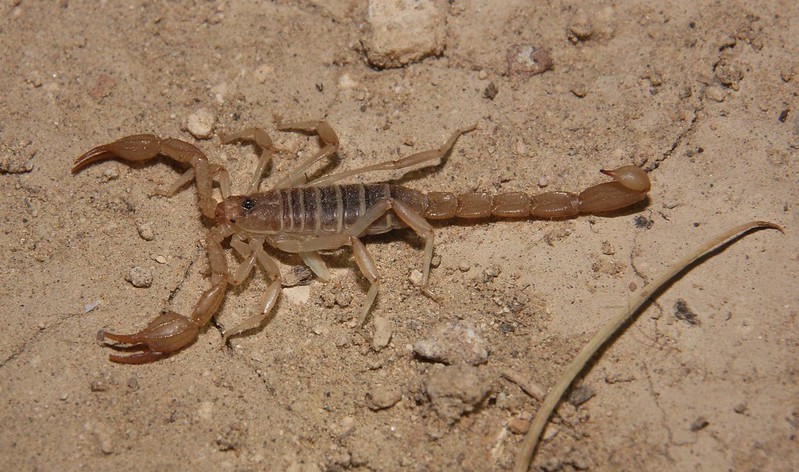
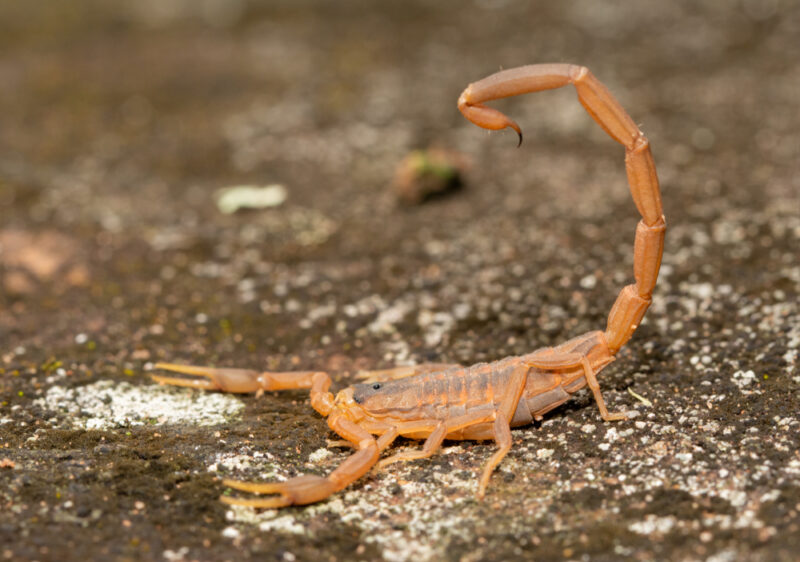
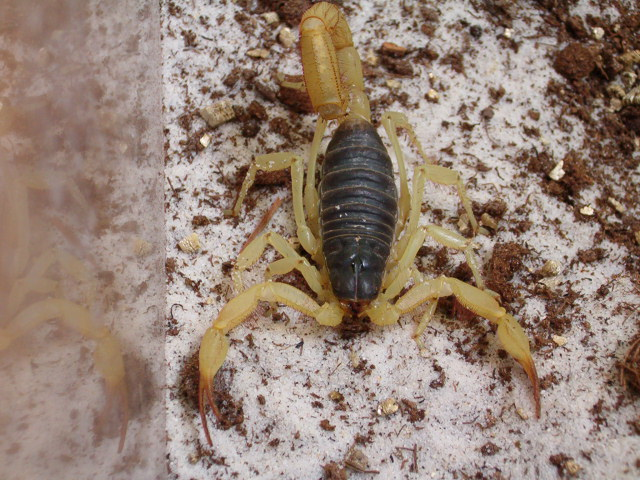
Scorpions
There are 3 different scorpion species present in the state of Colorado. Fortunately, none of them have stings that are any more medically significant than a wasp sting.
However, all venomous stings have the potential to produce severe allergic reactions. If you have blurred vision, muscle twitching, intense pain, or shortness of breath after experiencing a scorpion sting, seek immediate medical attention.
Also see: Scorpions in Colorado
Here is a list of Colorado’s scorpions.
- Northern Scorpion (Paruroctonus boreus)
- Northern Desert Hairy Scorpion (Hadrurus spadix)
- Common Striped Bark Scorpion (Centruroides vittatus)
Recent Posts
The only venomous snakes in Washington State are Northern Pacific Rattlesnakes. The Northern Pacific Rattlesnake (Crotalus oreganus oreganus) is a sub-species of the Western Rattlesnake. Anyone...
Skunks are not classified as true hibernators. But they go into a state of torpor when the weather gets cold. Skunks are light sleep hibernators, along with opossums, bears, and raccoons. ...

